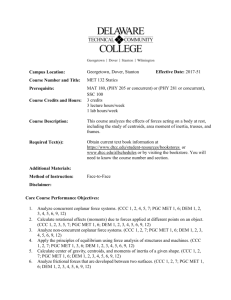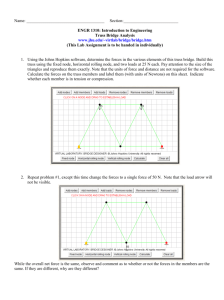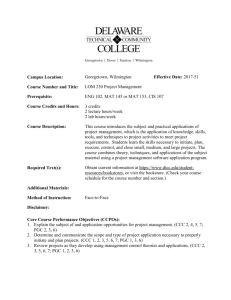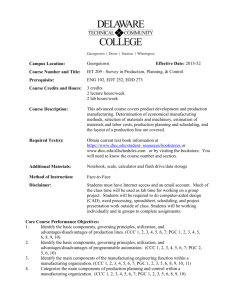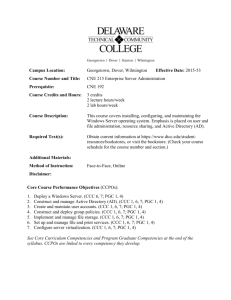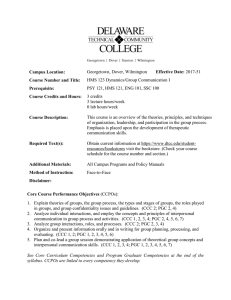CET 258 201751 - E
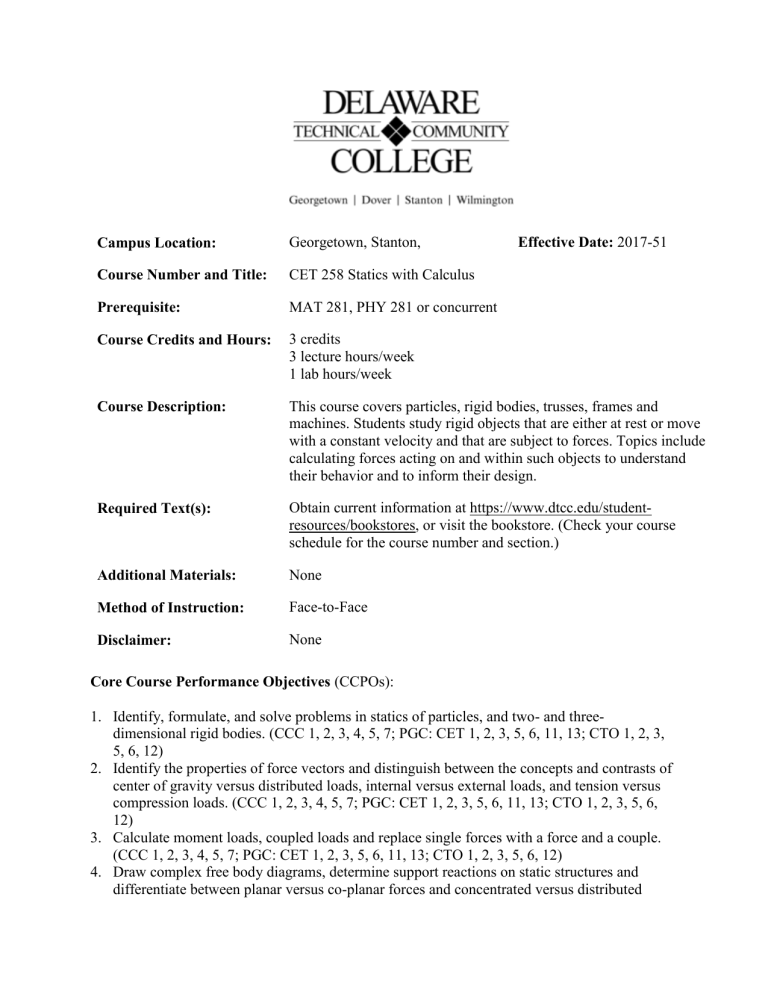
Campus Location: Georgetown, Stanton,
Course Number and Title: CET 258 Statics with Calculus
Prerequisite: MAT 281, PHY 281 or concurrent
Course Credits and Hours: 3 credits
3 lecture hours/week
1 lab hours/week
Course Description:
Required Text(s):
Effective Date: 2017-51
This course covers particles, rigid bodies, trusses, frames and machines. Students study rigid objects that are either at rest or move with a constant velocity and that are subject to forces. Topics include calculating forces acting on and within such objects to understand their behavior and to inform their design.
Obtain current information at https://www.dtcc.edu/studentresources/bookstores, or visit the bookstore. (Check your course schedule for the course number and section.)
Additional Materials:
Method of Instruction:
None
Face-to-Face
Disclaimer: None
Core Course Performance Objectives (CCPOs):
1.
Identify, formulate, and solve problems in statics of particles, and two- and threedimensional rigid bodies. (CCC 1, 2, 3, 4, 5, 7; PGC: CET 1, 2, 3, 5, 6, 11, 13; CTO 1, 2, 3,
5, 6, 12)
2.
Identify the properties of force vectors and distinguish between the concepts and contrasts of center of gravity versus distributed loads, internal versus external loads, and tension versus compression loads. (CCC 1, 2, 3, 4, 5, 7; PGC: CET 1, 2, 3, 5, 6, 11, 13; CTO 1, 2, 3, 5, 6,
12)
3.
Calculate moment loads, coupled loads and replace single forces with a force and a couple.
(CCC 1, 2, 3, 4, 5, 7; PGC: CET 1, 2, 3, 5, 6, 11, 13; CTO 1, 2, 3, 5, 6, 12)
4.
Draw complex free body diagrams, determine support reactions on static structures and differentiate between planar versus co-planar forces and concentrated versus distributed
loads. (CCC 1, 2, 3, 4, 5, 7; PGC: CET 1, 2, 3, 5, 6, 11, 13; CTO 1, 2, 3, 5, 6, 12)
5.
Identify and analyze zero-force/2-force truss members and determine the resultant forces acting on trusses using both the methods of joints and methods of sections. (CCC 1, 2, 3, 4, 5,
7; PGC: CET 1, 2, 3, 5, 6, 11, 13; CTO 1, 2, 3, 5, 6, 12)
6.
Calculate the centroids of both simple and complex structures. (CCC 1, 2, 3, 4, 5, 7; PGC:
CET 1, 2, 3, 5, 6, 11, 13; CTO 1, 2, 3, 5, 6, 12)
7.
Calculate the moment-of-inertia for both simple and composite areas and calculate the radius of gyration for an irregular area. (CCC 1, 2, 3, 4, 5, 7; PGC: CET 1, 2, 3, 5, 6, 11, 13; CTO 1,
2, 3, 5, 6, 12)
8.
Identify and evaluate the friction laws for dry surfaces and calculate the coefficients of friction for blocks, wedges, and belts. (CCC 1, 2, 3, 4, 5 ,7; PGC: CET 1, 2, 3, 5, 6, 11, 13;
CTO 1, 2, 3, 5, 6, 12)
9.
Demonstrate professional and ethical conduct as expected in industry. (CCC 1, 2, 3, 4, 5, 7;
PGC: CET 4, 6, 7, 8, 9; CTO 4, 6, 7, 8, 9)
See Core Curriculum Competencies and Program Graduate Competencies at the end of the syllabus. CCPOs are linked to every competency they develop.
Measurable Performance Objectives (MPOs):
Upon completion of this course, the student will:
1.
Identify, formulate, and solve problems in statics of particles and two- and three- dimensional rigid bodies.
Identify the standard procedures for performing numerical calculations and for solving problems.
Demonstrate adding and decomposing force vectors.
Solve particle equilibrium problems in 2D and 3D.
Solve rigid body equilibrium in 2D and 3D.
Develop shear force and bending moment diagrams.
2.
Identify the properties of force vectors and distinguish between the concepts and contrasts of center of gravity versus distributed loads, internal versus external loads and tension versus compression loads.
Illustrate and calculate force vector magnitudes and directions.
Explain the difference between center of gravity versus distributed loads, internal versus external loads and tension versus compression.
Perform vector addition by graphical representation and summation of components.
3.
Calculate moment loads, coupled loads and replace single forces with a force and a couple.
Calculate moment loads.
Calculate moments by means of moment arms, coupled loads and force/couple combinations.
4.
Draw complex free body diagrams, determine support reactions on static structures, and differentiate between planar versus co-planar forces and concentrated versus distributed loads.
Draw complete free body diagrams of structures in static equilibrium.
Determine support reactions of simple and complex beams.
Identify zero-force, 2-force, and 3-force members.
Differentiate and solve for coplanar-concurrent versus non-concurrent and concentrated versus distributed loads.
5.
Identify and analyze zero-force/2-force truss members and determine the resultant forces acting on trusses using both the methods of joints and methods of sections.
Identify zero-force and 2-force truss members.
Determine truss forces by both the “methods of joints” and “methods of sections.”
Differentiate between the members of a truss and a frame.
6.
Calculate the centroids of both simple and complex structures.
Identify and calculate the centroids of simple and complex areas as well as about various lines of reference.
Identify and calculate the center-of-gravity for simple and complex shapes.
7.
Calculate the moment-of-inertia for both simple and composite areas; calculate the radius of gyration for an irregular area.
Determine the moment-of-inertia for simple and complex areas.
Determine the radius of gyration of an irregular area.
8.
Identify and evaluate the friction laws for dry surfaces and calculate the coefficients of friction for blocks, wedges and belts.
Analyze the friction laws for dry surfaces.
Calculate the coefficients of friction and frictional forces on blocks, wedges, and belts.
9.
Demonstrate professional and ethical conduct as expected in industry.
Identify the need for self-discipline and time management in technical industries
Communicate and function effectively as a member of a team.
Evaluation Criteria/Policies:
Students must demonstrate proficiency on all CCPOs at a minimal 75 percent level to successfully complete the course. The grade will be determined using the DTCC grading system:
92 – 100 = A
83 – 91 = B
75 – 82 = C
0 – 74 = F
Students should refer to the Student Handbook (https://www.dtcc.edu/academics/studenthandbook) for information on the Academic Standing Policy, the Academic Integrity Policy,
Student Rights and Responsibilities, and other policies relevant to their academic progress.
Core Curriculum Competencies (CCCs are the competencies every graduate will develop):
1.
Communicate clearly and effectively both orally and in writing.
2.
Demonstrate effective problem solving and reasoning skills.
3.
Work effectively in groups of people from diverse backgrounds.
4.
Demonstrate ethical and professional understanding and conduct.
5.
Apply appropriate information literacy skills to locate, evaluate, and use information effectively.
6.
Use computer technology appropriate to the field.
7.
Use scientific and mathematical reasoning appropriate to the technology.
Program Graduate Competencies (PGCs are the competencies every graduate will develop specific to his or her major):
CETAASCET:
1.
Apply the knowledge, techniques, skills, and modern tools of the discipline to narrowly defined
2.
Apply a knowledge of mathematics, science, engineering, and technology to engineering technology problems that require limited application of principles but extensive practical knowledge.
3.
Conduct standard tests and measurements, and to conduct, analyze, and interpret experiments.
4.
Function effectively as a member of a technical team.
5.
Identify, analyze, and solve narrowly defined engineering technology problems.
6.
Apply written, oral, and graphical communication in both technical and nontechnical environments; and identify and use appropriate technical literature.
7.
Demonstrate an understanding of the need for and an ability to engage in self-directed continuing professional development.
8.
Integrate an understanding of and a commitment to address professional and ethical responsibilities, including a respect for diversity.
9.
Demonstrate a commitment to quality, timeliness, and continuous improvement.
10.
Utilize graphic techniques to produce engineering documents.
11.
Conduct standardized field and laboratory testing on civil engineering materials.
12.
Utilize modern surveying methods for land measurement and/or construction layout.
13.
Determine forces and stresses in elementary structural systems.
14.
Estimate material quantities for technical projects.
15.
Employ productivity software to solve technical problems.
CETAASCTO:
1.
Apply the knowledge, techniques, skills, and modern tools of the discipline to narrowly defined engineering technology activities.
2.
Apply a knowledge of mathematics, science, engineering, and technology to engineering technology problems that require limited application of principles but extensive practical knowledge.
3.
Conduct standard tests and measurements, and to conduct, analyze, and interpret experiments.
4.
Function effectively as a member of a technical team.
5.
Identify, analyze, and solve narrowly defined engineering technology problems.
6.
Apply written, oral, and graphical communication in both technical and nontechnical environments; and identify and use appropriate technical literature.
7.
Recognize the need for and an ability to engage in self-directed continuing professional development.
8.
Integrate a commitment to address professional and ethical responsibilities, including a respect for diversity.
9.
Demonstrate a commitment to quality, timeliness, and continuous improvement.
10.
Utilize graphic techniques to produce engineering documents.
11.
Utilize modern surveying methods for land measurement and/or construction layout.
12.
Determine forces and stresses in elementary structural systems.
